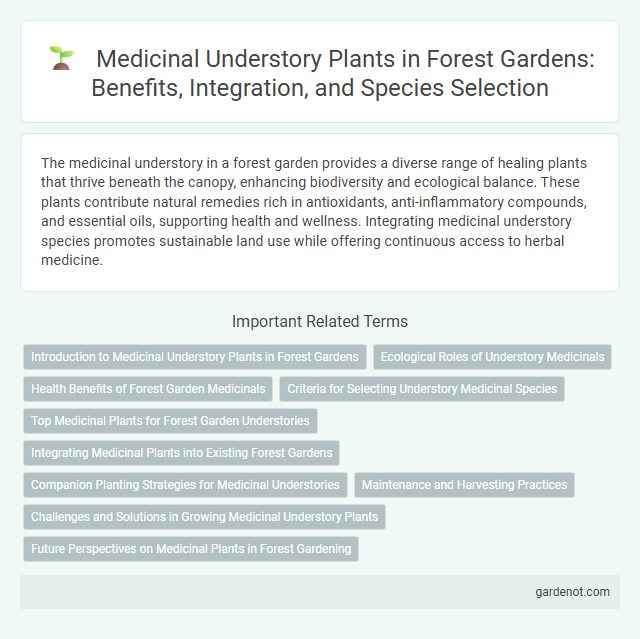The medicinal understory in a forest garden provides a diverse range of healing plants that thrive beneath the canopy, enhancing biodiversity and ecological balance. These plants contribute natural remedies rich in antioxidants, anti-inflammatory compounds, and essential oils, supporting health and wellness. Integrating medicinal understory species promotes sustainable land use while offering continuous access to herbal medicine.
Introduction to Medicinal Understory Plants in Forest Gardens
Medicinal understory plants in forest gardens provide essential therapeutic benefits while contributing to biodiversity and ecosystem health. These shade-tolerant species adapt well to the multilayered structure of forest gardens, offering natural remedies such as anti-inflammatory, antimicrobial, and antioxidant properties. Incorporating medicinal understory plants like goldenseal, ginseng, and wild ginger enhances both the ecological resilience and medicinal value of forest garden systems.
Ecological Roles of Understory Medicinals
Understory medicinal plants play critical ecological roles by enhancing biodiversity, supporting pollinators, and improving soil health within forest gardens. These plants contribute to microhabitat stability, fostering beneficial insect populations and facilitating nutrient cycling. Their presence in the understory layer also aids in pest regulation and promotes resilience against environmental stressors.
Health Benefits of Forest Garden Medicinals
Forest garden medicinals contribute significantly to holistic health by providing natural remedies packed with antioxidants, anti-inflammatory, and immune-boosting properties. Plants such as echinacea, elderberry, and ginseng thrive in the shaded understory, promoting respiratory health, enhanced immunity, and stress reduction. Integrating medicinal understory species into a forest garden creates a sustainable source of herbal medicine that supports physical well-being and ecological balance.
Criteria for Selecting Understory Medicinal Species
Selecting medicinal understory species for a forest garden requires evaluating shade tolerance, growth rate, and compatibility with canopy trees to ensure sustainable coexistence. Important criteria include the plant's efficacy for targeted health benefits, resilience to local pests and climate conditions, and ease of propagation. Prioritizing native or well-adapted species enhances biodiversity while maintaining ecological balance and maximizing medicinal yield.
Top Medicinal Plants for Forest Garden Understories
Top medicinal plants for forest garden understories include ginseng, known for its immune-boosting properties, and goldenseal, valued for its antibacterial and anti-inflammatory benefits. Echinacea thrives in shaded, forest-like environments, supporting respiratory health and wound healing. Other key understory plants like wild ginger and bloodroot offer natural remedies for digestion and skin conditions, making them essential components of medicinal forest gardens.
Integrating Medicinal Plants into Existing Forest Gardens
Integrating medicinal plants into existing forest gardens enhances biodiversity and supports natural healing ecosystems by utilizing layers of shade-tolerant herbaceous species such as Echinacea, Goldenseal, and St. John's Wort. These understory plants contribute to soil health through nutrient cycling and provide habitat for beneficial pollinators and microorganisms that promote resilient plant communities. Careful selection based on microclimate, soil conditions, and companion planting principles ensures successful establishment and long-term vitality of the medicinal understory.
Companion Planting Strategies for Medicinal Understories
Companion planting strategies for medicinal understories enhance plant health and boost therapeutic compound production by pairing compatible species such as echinacea with chamomile or calendula alongside comfrey. These combinations improve soil fertility, deter pests, and increase biodiversity, contributing to a resilient forest garden ecosystem. Selecting shade-tolerant medicinal plants like ginseng or goldenseal ensures optimal growth beneath canopy trees, maximizing medicinal yield while maintaining ecological balance.
Maintenance and Harvesting Practices
Effective maintenance of a medicinal understory in a forest garden involves regular pruning to promote healthy growth and prevent overcrowding, ensuring adequate sunlight reaches medicinal plants. Harvesting practices emphasize collecting leaves, roots, or flowers at peak potency, typically during specific seasonal windows to maximize therapeutic compounds. Sustainable methods include rotating harvest areas and minimal disturbance techniques to preserve plant populations and soil health over time.
Challenges and Solutions in Growing Medicinal Understory Plants
Growing medicinal understory plants in a forest garden presents challenges such as limited sunlight, competition for nutrients, and variable moisture conditions. Selecting shade-tolerant species, improving soil health through organic mulch and compost, and employing careful water management can enhance growth and plant resilience. Implementing companion planting strategies further supports medicinal plants by reducing pests and promoting beneficial microclimates.
Future Perspectives on Medicinal Plants in Forest Gardening
Medicinal understory plants in forest gardening offer sustainable sources of pharmaceuticals and herbal remedies, supporting biodiversity and ecosystem health. Advances in biotechnology and ethnobotanical research enhance the identification and cultivation of high-value medicinal species adapted to forest garden environments. Integrating these plants promotes resilient agroforestry systems with increased economic and ecological benefits, meeting future demands for natural health products.
Medicinal understory Infographic

 gardenot.com
gardenot.com